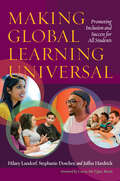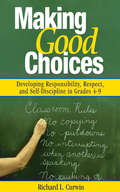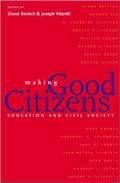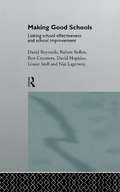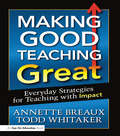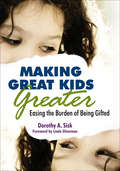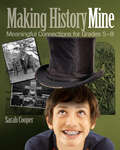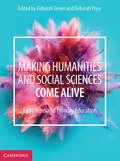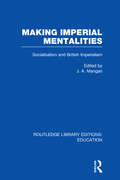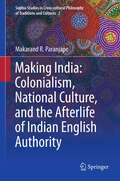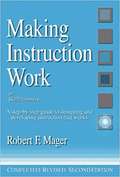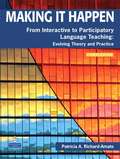- Table View
- List View
Making Friends, PreK–3: A Social Skills Program for Inclusive Settings (Second Edition)
by Ruth Herron Ross Elizabeth L. Roberts-PacchioneHelping students develop healthy social skills is child’s play <p><p> This newly retitled edition of the popular Wanna Play provides hundreds of fun and updated activities that help children learn how to behave appropriately and make friends. Ideal for teachers, counselors, and behavior therapists, included are tools for teaching emotion regulation, team-playing, and body safety to all children, making this resource an excellent fit for inclusive settings. New features include: <p> A social interaction checklist for identifying learners’ strengths and weaknesses <p> Teacher-friendly activities that can be used in small groups or with the whole class <p> A chapter on emotions
Making Games for Impact
by Kurt SquireDesigning games for learning: case studies show how to incorporate impact goals, build a team, and work with experts to create an effective game.Digital games for learning are now commonplace, used in settings that range from K–12 education to advanced medical training. In this book, Kurt Squire examines the ways that games make an impact on learning, investigating how designers and developers incorporate authentic social impact goals, build a team, and work with experts in order to make games that are effective and marketable. Because there is no one design process for making games for impact—specific processes arise in response to local needs and conditions—Squire presents a series of case studies that range from a small, playable game created by a few programmers and an artist to a multimillion-dollar project with funders, outside experts, and external constraints. These cases, drawn from the Games + Learning + Society Center at the University of Wisconsin–Madison, show designers tackling such key issues as choosing platforms, using data analytics to guide development, and designing for new markets. Although not a how-to guide, the book offers developers, researchers, and students real-world lessons in greenlighting a project, scaling up design teams, game-based assessment, and more. The final chapter examines the commercial development of an impact game in detail, describing the creation of an astronomy game, At Play in the Cosmos, that ships with an introductory college textbook.
Making Global Learning Universal: Promoting Inclusion and Success for All Students
by Hilary Landorf Stephanie Doscher Jaffus HardrickCo-published with While there is wide consensus in higher education that global learning is essential for all students’ success, there are few models of how to achieve this goal. The authors of this book, all of whom are from one of the nation’s largest and most diverse research universities, provide such a model and, in doing so, offer readers a broad definition of global learning that both encompasses a wide variety of modes and experiences—in-person, online, and in co-curricular activities at home and abroad—and engages all students on campus. They provide a replicable set of strategies that embed global learning throughout the curriculum and facilitate high quality, high-impact global learning for all students.The approach this book describes is based upon three principles: that global learning is a process to be experienced, not a thing to be produced; that it requires all students’ participation—particularly the underrepresented—and cannot succeed if reserved for a select few; and that global learning involves more than mastery of a particular body of knowledge. The authors conceptualize global learning as the process of diverse people collaboratively analyzing and addressing complex problems that transcend borders of all kinds. They demonstrate how institutions can enable all students to determine relationships among diverse perspectives on problems and develop equitable, sustainable solutions for the world’s interconnected human and natural communities. What’s more, they describe how a leadership process—collective impact—can enable all stakeholders across departments and disciplines to align and integrate universal global learning throughout the institution and achieve the aims of inclusive excellence.Providing examples of practice, this book:• Offers a model to make global learning universal;• Provides a definition of global learning that incorporates diversity, collaboration, and problem solving as essential components; • Describes effective leadership for implementation consistent with the attributes of global learning;• Illustrates integrative, high-impact global learning strategies within the access pipeline, students’ coursework, and co-curricular activities; • Offers practical strategies for global learning professional development, student learning assessment, and program evaluation;• Promotes inclusive excellence through universal global learning.
Making God Part of Your Family: The Family Bible Study Book
by Michael GradyIf your family thinks the Bible is boring, it&’s probably because they don&’t know the full story! Veteran Bible teacher Michael Grady has compiled the Old Testament stories into concise, thought provoking doses intended to stimulate family discussions. The Old Testament is a history of God&’s family and you just might be surprised to learn who&’s in your family tree! These stories provide a unique combination: they are both simple enough for your children to understand and deep enough for parents to grow in the knowledge and wisdom of God&’s Word. This vibrant, carefully researched volume will bring your family closer together and help you clearly establish your family&’s identity as children of God and brothers and sisters of Jesus. Making God Part of Your Family is not just a book of Bible stories. It is a study book. Whether your goal is to spend 10–15 minutes on a dinner-time devotional or bedtime reading with your children, or spend more in-depth study time together once a week, this flexible resource will make it easier to carve out time amidst hectic schedules to study the Bible together, and help you to: Develop a better and deeper relationship with God our Father, and his son, JesusLearn how we are part of God&’s familyLearn how God expects us to live amidst the joys and sorrows of lifeApply practical lessons and eternal truths to the situations you face today
Making God Part of Your Family: The Family Bible Study Book Volume 3
by Michael GradyMaking God Part of Your Family Volume 3 strives to bring God’s plan to life for individuals and their families as He chose to reveal these truths through the stories in the Old Testament.Most would agree that the Old Testament stories can be difficult to relate to and understand. Veteran Bible teacher Michael Grady retells the Old Testament stories in concise, thought-provoking doses that are easy to understand and intended to stimulate family discussions. He demonstrates that the Old Testament stories are much more than just a history of the Israelites (God’s chosen family); they are parables detailing God’s guide to living and his eternal plan for redemption and salvation for all who choose to believe. The stories in Making God Part of Your Family Volume 3 provide a unique combination—they are both simple enough for children to understand and deep enough for parents to grow in the knowledge and wisdom of God’s Word. This vibrant, yet carefully researched volume brings families closer together and helps them clearly establish their identity as children of God and brothers and sisters of Jesus.
Making God Part of Your Family: The Family Bible Study Guide -volume 2 (The Family Bible Study Book #2)
by Michael GradyA veteran Bible teacher offers Old Testament stories and family discussion prompts in this accessible yet thoughtful Bible study book. In Making God Part of Your Family, Bible teacher Michael Grady presents the Old Testament stories in concise, thought provoking doses intended to stimulate family discussions. These stories are both simple enough for your children to understand and deep enough to offer new insights for parents who want to further their knowledge of God&’s Word. More than just a collection of Bible stories, this study book can help you more firmly establish your family&’s identity as children of God and brothers and sisters of Jesus. Whether your goal is to spend ten to fifteen minutes a day on a dinner-time devotional or bedtime reading with your children or spend more in-depth study time together once a week, this flexible resource will make it easier to establish a family routine amidst hectic schedules. Making God Part of Your Family can help you: Develop a deeper relationship with God our Father, and his son, JesusLearn how we are part of God&’s familyLearn how God expects us to live amidst the joys and sorrows of lifeApply practical lessons and eternal truths to the situations you face today
Making Good Choices: Developing Responsibility, Respect, and Self-Discipline in Grades 4-9
by Richard L. CurwinThis guidebook offers teachers eight ready-to-use strategies to help students make good choices for good behavior in the classroom as well as in the real world.
Making Good Citizens: Education and Civil Society
by Diane Ravitch Joseph P. ViterittiLeading thinkers from a variety of disciplines probe the relation between a healthy democracy and education. Contributors such as Jean Bethke Elshtain, Nathan Glazer, Robert Putnam, Jack Rakove, and Alan Wolfe discuss topics that range from the place of religion in public life to political conflict in a pluralist society to the problems of racial inequality.
Making Good Schools: Linking School Effectiveness and Improvement (Educational Management Ser.)
by David Hopkins David Reynolds Louise Stoll Bert P.M. Creemers Robert Bollen Nijs LagerweijThe disciplines of school effectiveness research and school improvement practice and research have been apart for too long. This book is the first major attempt, by leading writers and practitioners in these fields, to bring the areas together in a coherent way. Existing knowledge about the characteristics of `good' schools is outlined, together with the knowledge base about how to `make schools good schools'. The book also makes an entirely original contribution to re-thinking practice in school improvement that can revolutionise our thinking in the late 1990s, and which can be of use to academics, to policymakers and to the practitioners which much existing work has neglected.
Making Good Teaching Great: Everyday Strategies for Teaching with Impact
by Annette Breaux Todd WhitakerEvery good teacher strives to be a great teacher - and this must-have book shows you how! It's filled with practical tips and strategies for connecting with your students in a meaningful and powerful way. Learn how to improve student learning with easy-to-implement daily activities designed to integrate seamlessly into any day of the school year. This is a readable, hands-on guide for both new and seasoned teachers - complete with "20-Day Reality Checks" so you can reflect on your progress and identify areas for improvement.
Making Great Kids Greater: Easing the Burden of Being Gifted
by Dorothy SiskBridging the gap between gifted children's cognitive and social-emotional development, this book offers strategies to expand their talents with consideration for their unique needs.
Making Hard Decisions with Decision Tools
by Robert T. Clemen Terence ReillyThis book teaches the fundamental ideas of decision analysis, without an overly technical explanation of the mathematics used in decision analysis. This new version incorporates and implements the powerful DecisionTools® software by Palisade Corporation, the world's leading toolkit for risk and decision analysis. At the end of each chapter, topics are illustrated with step-by-step instructions for DecisionTools®. This new version makes the text more useful and relevant to students in business and engineering.
Making Haste Slowly: The Troubled History of Higher Education in Mississippi
by David G. SansingThe troubled history of higher education in Mississippi is a mirror image of the cultural and political dynamics that have shaped the state's history over the last two centuries. The interaction between race and place, the juxtaposition of wealth and poverty, illiteracy and literary genius, the conflict and change and continuity that mark the contours of its history, have influenced the development of higher education in Mississippi.In this study of the origin and evolution of the state's collegiate system, David Sansing examines higher education in its broad cultural context and its elaborate involvement with the rest of society. Although he focuses on one southern state, he links the growth of higher education in Mississippi to both regional and national developments.Sansing also contrasts the strong popular support for higher education with the general neglect of public schools, a longstanding tradition in Mississippi that dates from the pre-Civil War period. From the antebellum artisans and the sharecroppers of the Gilded Age, to the redneck farmers of the debt-ridden twenties and post-World War II blacks with their rising expectations, Mississippians have struggled and sacrificed to send their children to college as a way up and out of poverty.Sansing's history of higher education in Mississippi is the first such study since 1899 and is the most recent of the five modern state histories of higher education. This path-breaking study traces the gradual and often controversial expansion of Mississippi's institutions of higher learning from the founding of Jefferson College in 1802, through the sectional crisis and Civil War, the Gilded Age, the Great Depression, the Bilbo Purge, World War II, the Meredith Crisis, and Civil Rights Revolution.
Making History Mine: Meaningful Connections for Grades 5-9
by Sarah CooperMiddle school history teachers confront the same challenge every day: how to convey the breadth and depth of a curriculum that spans centuries, countries, and cultures. In Making History Mine, Sarah Cooper shows teachers how to use thematic instruction to link skills to content knowledge. By combining thought-provoking activities and rich assessments, Sarah encourages teachers to challenge students to make history personal and relevant to their lives.
Making Humanities and Social Sciences Come Alive: Early Years and Primary Education
by Deborah Price Deborah GreenHumanities and Social Science (HASS) education is integral in the development of active and informed citizens, and encourages learners to think critically, solve problems and adapt to change. Making Humanities and Social Sciences Come Alive: Early Years and Primary Education prepares pre-service educators to become high quality HASS educators who can unlock the potential of all students. Closely aligned with the Australian Curriculum and Early Years Learning Framework, this text is designed to enhance teaching practices in history, geography, economics and business, and civics and citizenship. The text provides readers with an in-depth understanding of the curriculum structure, the individual disciplines, pedagogical approaches to teaching HASS, inclusivity, global connections and the transition to practice. Examples are provided for early childhood and primary education, making this an inclusive, versatile and comprehensive text. This book is an invaluable resource that provides pre-service educators with the knowledge and skills to deliver this exciting curriculum.
Making Humanities and Social Sciences Come Alive: Early Years and Primary Education
by Deborah Price Deborah GreenA strong foundation in Humanities and Social Sciences helps young learners to think critically, communicate effectively, make decisions and adapt to change. Making Humanities and Social Sciences Come Alive prepares pre-service educators to effectively teach and integrate the crucial learning area of HASS, incorporating the sub-strands of History, Geography, Civics and Citizenship, and Economics and Business. The second edition provides a comprehensive introduction to HASS education for both the early years and primary education. Closely aligned with the latest versions of the Australian Curriculum and the Early Years Learning Framework, the text delivers an in-depth understanding of the curriculum structure, pedagogical approaches to teaching HASS, inclusivity, global connections and the transition to practice. Wide-ranging updates include strengthened links to demonstrate the relevance of theory and research to classroom practice, and applications for integrating the Australian Curriculum's general capabilities and cross-curriculum priorities.
Making Imperial Mentalities: Socialisation and British Imperialism (Routledge Library Editions: Education)
by J. A. ManganThis book discusses the way in which those born into the British empire were persuaded to accept it, often with enthusiasm. The study compares the perceptions of people at ‘home’, in the dominions and in the colonies. Across the diversity of imperial territories it explores themes such as the diverse nature of political socialisation, the various agents and agencies of persuasion, reaction to the ‘experience of dominance’ by dominant and dominated, the paradoxical impact of the missionary and the subversive role of some women. It also considers the significant issues of colonial adaptation, resistance and rejection, and the post-imperial consequences of imperialism.
Making Inclusion Work for Children with Dyspraxia: Practical Strategies for Teachers
by Lois Addy Gill DixonDrawing on their considerable experiences of the syndrome, as well as current research findings, the authors help teachers and other education professionals to better understand the needs of a dyspraxic child. Through practical strategies, they show how teachers can make all the difference to a child's ability to succeed in the classroom, and case studies show how parents, teachers and therapists can work together to facilitate learning. Whilst providing a unique insight and approach to the complex condition of dyspraxia, this lively, informative text also examines specific cases and scenarios, considering the perspectives of teachers and parents. It handles a range of crucial topics such as: * issues surrounding diagnosis* the developmental differences and characteristics of dyspraxia* conventional and alternative intervention strategies* an exploration of the pressure of families* ways of improving home/school liaison. Teachers, SENCOs and other educational professionals will find this book provides a wealth of essential information and guidance, whilst parents will also find much to support them in the daily care and welfare of their child.
Making Inclusion Work: Effective Practices for All Teachers
by Bob Algozzine Luann Jordan John BeattieLearn the best methods for teaching students with disabilities in an inclusive classroom!In today's classrooms, teachers must meet the educational needs of students of all ability levels, including students with disabilities. This invaluable resource offers elementary and secondary teachers a deeper awareness of "what works" when teaching students with disabilities in general education classrooms. Grounded in extensive special education research, this book will enlighten teachers with a greater understanding of special education students and how to teach them successfully.For teaching students with the most common disabilities in classes with their nondisabled peers, general and special education teachers alike will get the most current information on issues such as: Developing Individualized Education Programs Teaching reading successfully Managing behavior and motivating students Organizing classrooms and lessons effectively Using cognitive strategies successfully Making appropriate accommodations and modifications Assessing students, grading, and collecting data Working with parents and families Collaborating with other teachers and parentsOne of the greatest challenges teachers face today is how to ensure that all students succeed, regardless of their ability. Rooted in the best research and practice, this essential resource provides the tools needed to create an inclusive classroom and demonstrates how to teach classes successfully.
Making Inclusive Higher Education a Reality: Creating a University for All
by Anna M. Kelly Lisa Padden Bairbre FlemingRevealing higher education inclusive practice in action, this key title showcases a range of international case studies from a number of universities in order to highlight approaches to developing a culture of access and inclusion. It provides detailed information on how to transform institutional commitment to access and diversity into systemic change and the creation of a university for all. By deconstructing assumptions and practices and offering a range of inclusive techniques and case studies to challenge and enhance instruction, this book moves the conversation about inclusivity from a concept to a reality. It evokes and prompts solutions to everyday challenges experienced by those working in higher education and offers the reader a ringside seat to its application, implementation and unearthing inclusive practice gems which showcase inclusive practice at its best. Providing a whole-institution perspective of student access and inclusion, citing case studies and sharing real world experience, this book will appeal to academic leaders, faculty and professionals in higher education, as well as policy makers. In particular, those charged with addressing issues of access, diversity and inclusion in higher education will find this a vital read.
Making India: Colonialism, National Culture, and the Afterlife of Indian English Authority
by Makarand R. ParanjapeCompared to how it looked 150 years ago at the eve of the colonial conquest, today's India is almost completely unrecognizable. A sovereign nation, with a teeming, industrious population, it is an economic powerhouse and the world's largest democracy. It can boast of robust legal institutions and a dizzying plurality of cultures, in addition to a lively and unrestricted print and electronic media. The question is how did it get to where it is now? Covering the period from 1800 to 1950, this study of about a dozen makers of modern India is a valuable addition to India's cultural and intellectual history. More specifically, it shows how through the very act of writing, often in English, these thought leaders reconfigured Indian society. The very act of writing itself became endowed with almost a charismatic authority, which continued to influence generations that came after the exit of the authors from the national stage. By examining the lives and works of key players in the making of contemporary India, this study assesses their relationships with British colonialism and Indian traditions. Moreover, it analyzes how their use of the English language helped shape Indian modernity, thus giving rise to a uniquely Indian version of liberalism. The period was the fiery crucible from which an almost impossibly diverse and pluralistic new nation emerged through debate, dialogue, conflict, confrontation, and reconciliation. The author shows how the struggle for India was not only with British colonialism and imperialism, but also with itself and its past. He traces the religious and social reforms that laid the groundwork for the modern sub-continental state, proposed and advocated in English by the native voices that influenced the formation India's society. Merging culture, politics, language, and literature, this is a path breaking volume that adds much to our understanding of a nation that looks set to achieve much in the coming century.
Making Instruction Work: Or Skillbloomers: A Step-By-Step Guide to Designing and Developing Instruction That Works
by Robert MagerMaking Instruction Work simplifies the complicated task of developing instruction and gives you practical procedures for increasing its effectiveness and efficiency. It takes you step-by-step through the design and development process, providing an invaluable overview of the steps critical to achieving your instructional goals
Making It Better
by Barbara OehlbergMore than 75 empowering and healing classroom activitiesChildren living with uncertainty and insecurity often have difficulty focusing on learning. They might demonstrate disrespectful or defiant behaviors, act out, or act with aggression. As an educator, you may provide the only stability in their otherwise turbulent world.Making It Better explains trauma-informed education, an approach that recognizes the impact of traumatic stress on children and its effect on the growing brain, and applies the latest neurological research to teaching methods, disciplinary policies, and interactions to support grieving children.This book responds to the learning and behavioral needs of children who have experienced traumatic events or toxic stress-such as natural disasters, community violence, or abuse or neglect within the child's familial relations-and includes a collection of activities and strategies to help children heal and feel empowered.Distressed children need absolute emotional security and an opportunity to engage in healing activities. With your help, children can begin to build resiliency and find renewed hope for the future.Barbara Oehlberg, MA, is an education and child trauma consultant who has presented for many organizations throughout the country. With a career that has spanned many levels, Barbara has spent more than 30 years making a positive impact on children's lives.
Making It Happen, from Interactive to Participatory: Language Teaching, Evolving Theory and Practice (4th Edition)
by Patricia A. Richard-AmatoNew to this edition: Separate chapters on implicit/explicit teaching and on a sociocultural/cognitive synthesis. New sections on focus form strategies, World Englishes, research directions, corpus analysis, dialogical assessment, and the Acoma heritage language program. The research has been updated throughout and reflects influential thinking for the 21st century. Part 1: Theoretical Considerations - Explores current theory and research; builds a case for emergent participatory teaching; and highlights literacy development, self-directed learning strategies, and current assessment issues and practices. Part II: Exploring Methods and Activities - Presents a practical reservoir from which teacher can draw as they develop their own methodologies and local practice. Part III: Putting It All Together: Some Practical Issues - Considers issues critical to program development, lesson design, textbook and computer program selection, video use; teacher research and professional development (including SOP). Part IV: Programs in Action - Describes K-Adult Programs (ESL, Foreign Language, Bilingual, and Tribal Heritage). Part V: Case Studies: Teacher Narrations to Stimulate Professional Dialogue - Presents case studies, ranging from kindergarten through university levels.
Making It Work: Educating The Blind/Visually Impaired Student in the Regular School (Critical Concerns in Blindness Series)
by Carol CastellanoMaking It Work is destined to be the definitive guide for years to come on how to make the regular school education a successful experience for blind/visually impaired children. With chapters flowing logically and full of detailed, useful information, it will be an essential handbook for school staff, specialized service providers, and parents of blind/visually impaired children. This is an exquisite, enlightened guide for the education of blind/visually impaired children in the new millennium.


